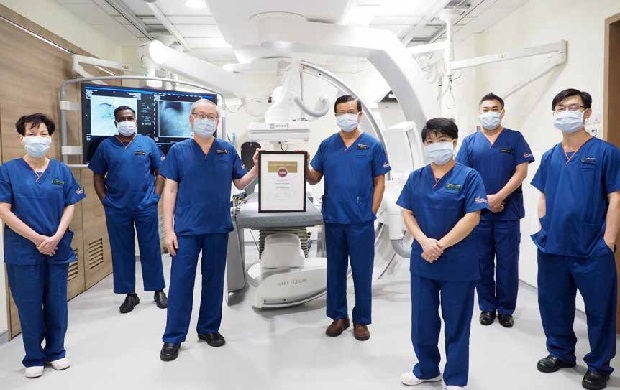
Singapore General
Hospital is the first
hospital in Asia to
achieve the global
gold standard for
interventional
oncology care, a
rapidly growing field
in cancer treatment.
<<The accreditation is a recognition of the quality of interventional oncology services that his team has been providing, says Associate Professor Tay Kiang Hiong.>>
Singapore General Hospital (SGH) has joined an international elite club after its Department of Vascular and Interventional Radiology received accreditation from the International Accreditation System for Interventional Oncology Services (IASIOS).
SGH is the first in Asia and just one of 10 institutions around the world to gain the prestigious certification, which sets a gold standard in safe, effective and transparent patient care in interventional oncology (IO) services. This means the hospital’s protocols and treatment outcomes in IO procedures are of the highest international standards.
"Receiving the accreditation is a deep honour for SGH, and acknowledges the high quality of clinical services that we have been providing," said Associate Professor Tay Kiang Hiong, Senior Consultant and Head, Department of Vascular and Interventional Radiology, SGH.
IO is the youngest subspeciality of interventional radiology (IR), itself an important and growing field that uses ultrasound, fluoroscopy and magnetic resonance imaging (MRI) to diagnose, treat or relieve symptoms of cancer. Like IR, IO is rapidly growing because of its effectiveness and relatively lower risks. SGH performs about 3,500 IO-related procedures a year, or 30 per cent of the hospital’s annual interventional radiology procedures.
IO, a targeted cancer treatment, is now considered the fourth pillar of modern cancer care, alongside cancer treatment stalwarts — surgery, chemotherapy and radiotherapy.
IO treatments can treat early-stage cancers, and in advanced cases, alleviate cancer-related symptoms, especially cancer pain that does not respond to conventional treatments or painkillers. Indeed, IO plays a large role in palliative care for advanced cancer patients.
In IO, a needle can be directly inserted through the skin into the tumour or into an artery, usually at the groin or wrist. In the latter technique, a very slender tube called a catheter is then manipulated under x-ray guidance all the way into the liver, for instance. "There, a host of things like chemo agents or radioactive particles are delivered to kill the tumour, sparing normal tissues around it," said Prof Tay.
As the incision is so small, the patient experiences less pain, a shorter hospital stay and a faster recovery, compared to someone undergoing open surgery. IO treatments are also relatively painless and can be performed under local anaesthesia or sedation, and not general anaesthesia, which itself represents a risk for patients.
In that regard, IO is a viable option for those who are not able to undergo surgery, such as elderly patients or those with multiple other illnesses.
In early 2018, the IASIOS invited SGH — one of 12 hospitals around the world — to enrol as a pilot centre for accreditation. SGH, which has been offering IO services since the late 1980s, formally enrolled in 2020 and received accreditation in May 2021.
Underscoring the growing importance of IR services, this subspecialty became a full department within SGH’s Division of Radiological Sciences, and is the first in this field in the country. Separating from its former parent, the Department of Diagnostic Radiology, allows the department to focus its efforts on research and care improvement.
Get the latest updates about Singapore Health in your mailbox! Click here to subscribe.













 Get it on Google Play
Get it on Google Play